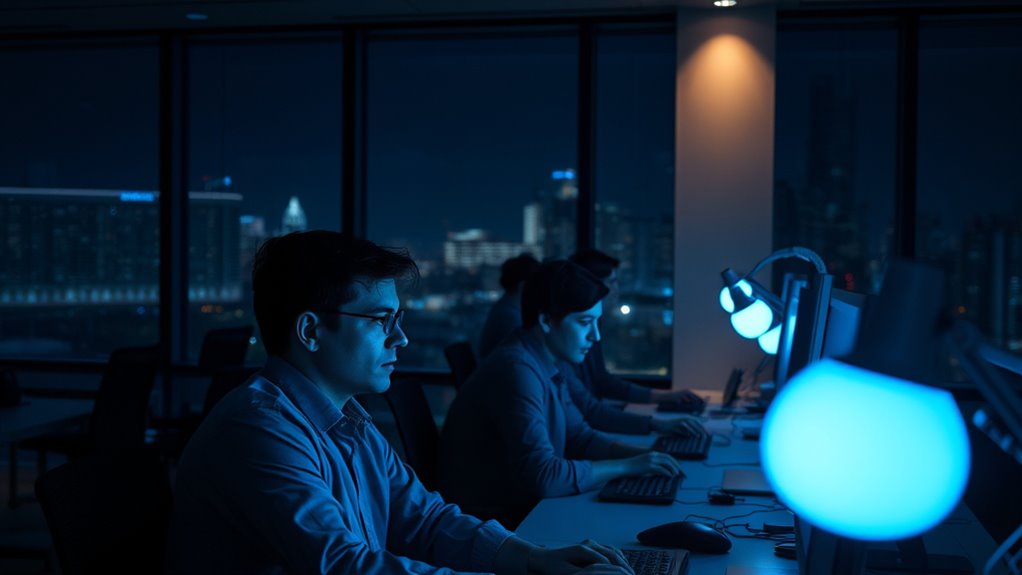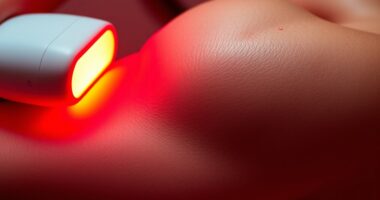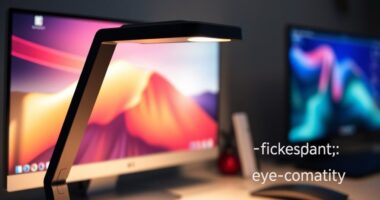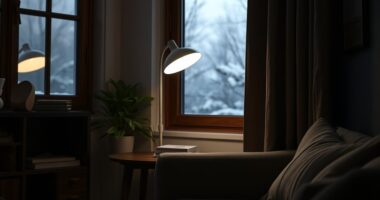To minimize health risks as a night-shift worker, use proper lighting strategies like bright, blue-enriched lights during your shift to boost alertness. In contrast, dim or red lights before sleep can promote melatonin production and improve rest. Wear blackout curtains and limit exposure to screens before bedtime. Managing light exposure helps keep your circadian rhythm aligned and reduces long-term health issues. Keep exploring ways to optimize your lighting environment for better sleep and overall well-being.
Key Takeaways
- Implement bright, blue-enriched lighting during night shifts to boost alertness and mimic natural daylight.
- Use dimmed, warmer lighting before sleep periods to promote melatonin production and improve rest quality.
- Utilize blackout curtains and light-blocking devices to minimize external light exposure during daytime sleep.
- Incorporate wearable or targeted light therapy devices to help reset circadian rhythms when natural light is limited.
- Educate workers on managing light exposure to reduce circadian disruption and long-term health risks.

Working during the night can disrupt your body’s natural rhythms, making proper lighting essential for maintaining alertness and safety. When you’re active during irregular hours, your internal biological clock, known as your circadian rhythm, gets thrown off. This disruption can lead to circadian disruption, which affects your sleep-wake cycle and overall health. One key factor here is melatonin, the hormone that signals your body it’s time to sleep. Exposure to inappropriate lighting at night can cause melatonin suppression, making it harder for you to fall asleep during the day and increasing fatigue during your shift. Without proper lighting, your body may struggle to recognize when it’s time to stay alert or wind down, worsening your health over time.
To combat this, it’s *vital* to use lighting that supports your alertness during the night and helps restore your natural rhythms when it’s time to rest. Bright, blue-enriched light is particularly effective because it mimics natural daylight, which helps suppress melatonin during your shift, keeping you awake and focused. When you work in environments with inadequate lighting, your ability to stay alert diminishes, increasing the risk of errors or accidents. Proper lighting not only enhances your concentration but also helps maintain your circadian health by reducing the extent of circadian disruption. For example, installing high-intensity, cool-white lighting in your workspace can provide the stimulation needed to stay attentive and productive.
Conversely, when it’s time to sleep, you should minimize exposure to bright lights, especially those with high blue light content, as they continue to suppress melatonin and interfere with your ability to rest. Using blackout curtains and dimming the lights before you sleep can help your body produce melatonin naturally, promoting better quality sleep. Managing light exposure strategically can help you reset your circadian rhythm more efficiently, reducing long-term health risks like metabolic issues, cardiovascular problems, and mental health concerns. It is also beneficial to be aware of the impact of light spectrum on melatonin suppression and sleep quality, enabling you to choose lighting solutions that support your health. Additionally, using wearable light therapy devices if your shift schedule makes it difficult to get natural daylight can help realign your internal clock, easing the symptoms of circadian disruption.
Frequently Asked Questions
How Does Light Exposure Affect Long-Term Mental Health?
You might wonder how light exposure impacts your mental health over time. When your circadian rhythm gets disrupted by irregular light patterns, it can lead to mood disorders like depression or anxiety. Proper lighting helps regulate your internal clock, reducing this risk. Consistent, natural light exposure supports mental well-being by maintaining circadian alignment, ultimately lowering the chances of developing long-term mood disorders and improving overall mental health.
Are There Specific Light Wavelengths More Beneficial for Night-Shift Workers?
Think of blue light as the conductor of your circadian orchestra. Research shows blue light has a strong circadian influence, helping night-shift workers stay alert. However, exposure to blue wavelengths late at night can disrupt sleep. Using blue light filters or limiting exposure during off-hours can help. You benefit from wavelengths that mimic natural daylight, supporting alertness without compromising your sleep cycle.
How Can Workplaces Implement Effective Lighting Adjustments?
You can improve workplace ergonomics by implementing adjustable lighting that mimics natural daylight, helping night-shift workers stay alert and healthy. Provide employee training to educate staff on ideal lighting practices and the importance of proper exposure. Regularly assess and adjust lighting setups based on feedback, ensuring that workers have the right light wavelengths. This proactive approach minimizes health risks and boosts productivity during night shifts.
What Are the Risks of Inadequate Lighting During Night Shifts?
Inadequate lighting during night shifts can lead to circadian disruption and visual fatigue. You might find it harder to focus, increasing errors and accidents. Poor lighting can also disturb your sleep patterns, making it tough to rest and recover. Over time, this imbalance raises health risks like fatigue, mood issues, and long-term conditions. Ensuring proper lighting helps maintain alertness, reduces visual strain, and supports your overall well-being during night work.
Can Personal Light Devices Improve Sleep Quality for Night Workers?
Ever wondered if personal light devices can help night workers? They can, by reducing blue light exposure during night shifts, which helps minimize circadian disruption. Using these devices, you can create a more sleep-friendly environment, promoting better sleep quality. While they’re not a perfect fix, they’re a practical way to support your health and align your sleep patterns with your unique schedule.
Conclusion
By implementing proper lighting strategies, you can profoundly reduce health risks for night-shift workers. Did you know that exposure to bright, blue-enriched light can improve alertness and shift adaptation? Using tailored lighting not only boosts performance but also protects your health. Don’t underestimate the power of good lighting—it’s a simple yet effective way to support your well-being during those long, unconventional hours. Prioritize proper lighting to stay alert, healthy, and safe on your night shifts.









